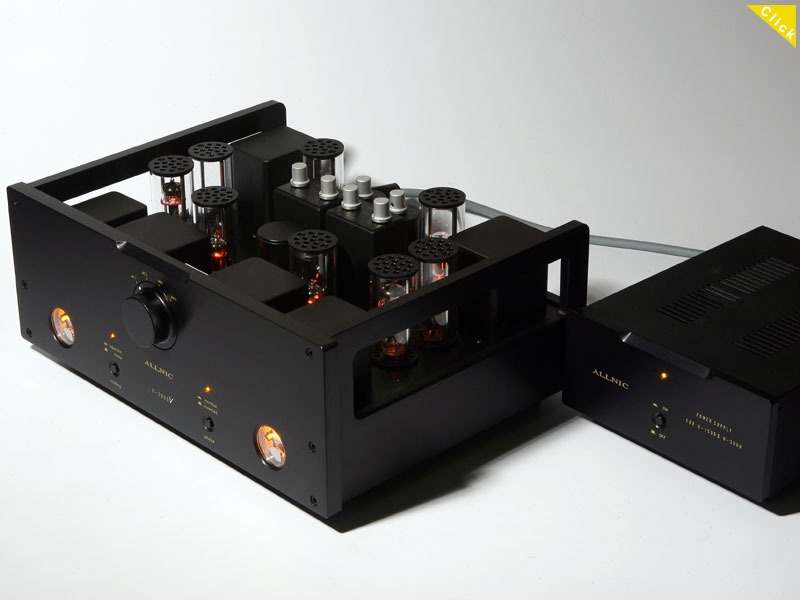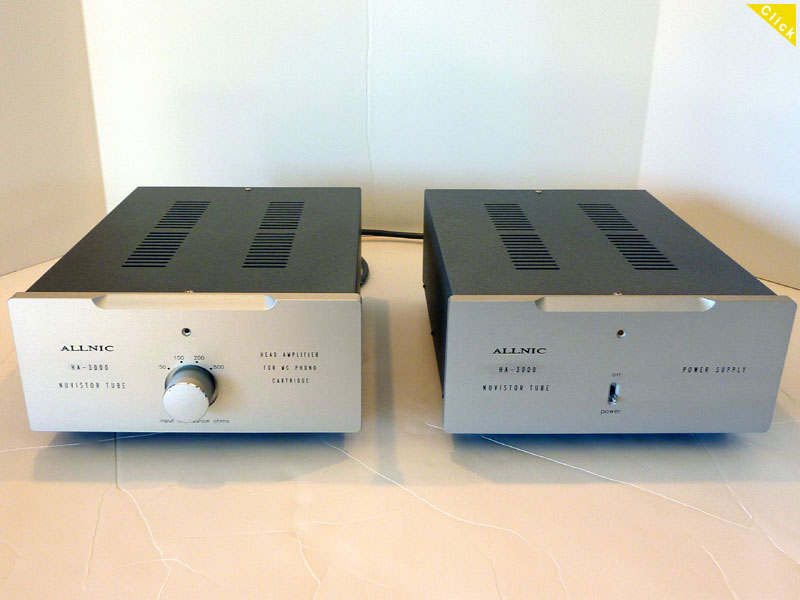Analog by Allnic
hortly after my review of the Allnic H-3000 phono stage appeared, David Beetles, who oversees worldwide distribution of Allnic products, let me know that there was an upgraded version of the company's top phono stage. Allnic CEO Kang Su Park had finished work on a new H-3000 that incorporated switching for multiple EQ curves, so owners could play their non-RIAA records with the correct equalization. Like the H-3000 I reviewed, this new unit, dubbed the H-3000V ($13,900), used an inductance-capacitance-resistance (LCR) network for RIAA equalization, instead of the common capacitance/resistance (CR) network. The advantages of an LCR network are many, including low impedance and low signal loss, but perhaps the most important is one Demetris Backlavas, head of Greek electronics manufacturer Ypsilon and a proponent of LCR networks, pointed out in his interview with Michael Fremer: impedance stability, which translates to greater equalization accuracy, especially when tubes are part of the circuit. The H-3000V's LCR networks -- one for each channel -- have multiple taps, which allow for generous adjustment. The H-3000V's manual outlines ten different combinations of roll-off and turnover settings that cover the EQ settings for nearly 20 record labels. I have maybe a handful of pre-RIAA records that are not covered, and in these cases it's a matter of researching the correct EQ settings and then dialing them in on the H-3000V. There are four roll-off and turnover settings per channel. The H-3000V also uses new-and-better output transformers that Kang Su Park designed. Owners of earlier H-3000 phono stages can have their units upgraded with the new transformers for $2200 (swapping LCR networks isn't possible). Allnic dealers will handle this. Along with the H-3000V, I also received a rather unusual Allnic product, the HA-3000 head amp ($4900). Head amps were much more prevalent twenty or more years ago, before the introduction of designer step-up transformers. They connected to any moving-magnet input, providing a gain stage before that of the phono stage itself, which was necessary with low-output moving-coil cartridges. Thus, with the HA-3000 connected to the H-3000V's moving-magnet input, the latter's step-up transformers were not in the signal path, and loading was applied with greater precision. A knob on the front of the HA-3000's main chassis -- it comes with a very robust and heavy separate power supply -- has settings for 50, 100, 200 and 500 ohms, which are common values for use with moving-coil cartridges. Adding to the HA-3000's esoteric nature is its pair of 7895 nuvistor tubes, which provide the gain. RCA developed these thimble-shaped, metal-body vacuum tubes at the end of the 1950s for use in the TV sets of the day. The 7895 is a high-mu triode with a number of advantages over typical small-signal triodes. In the case of the HA-3000, the 7805 nuvistor was chosen for its high-gain and low-noise capabilities, both of which are vitally important for a phono preamp, especially one like the HA-3000, which will be followed by a second gain stage. Inside the HA-3000 there are actually sockets for two pairs of nuvistors, but Kang Su Park refined the circuit, eliminating one pair and reducing the noise of the unit noticeably. A pair of 3.6V lithium-ion batteries provide DC that keeps the tubes' bias at a fixed point. The HA-3000's circuit board is mounted on rubber grommets that aid in isolating it from microvibration and also keep the nuvistor tubes seated during shipment. In my review of the H-3000, I praised its high resolution and appealing musical ease -- sonic traits that are not often found together. Above these, however, I was impressed with the H-3000's ability to conjure fully realized images in distinct space. I wrote, "Consistently, a unique relationship between image specificity and solidity presented the music with spooky palpability. . . . The H-3000 was clearly in a league of its own here." None of this changed with the H-3000V, which still could raise the hair on the back of my neck with recordings that had copious spatial information. The new transformers also gave the H-3000V an improved sense of authority, both rhythmic and dynamic. The low end had improved propulsiveness, while large-scale dynamics seemed to extend further at their most macro reaches. The H-3000V sounded robust while retaining the H-3000's imaging prowess, making the transformer upgrade much more than sonically worthwhile. Both the H-3000 and H-3000V have pairs of moving-magnet and moving-coil inputs -- perfect for someone like me with pairs of tonearms and cartridges: one for stereo and another for mono. I've celebrated the virtues of playing mono records with mono cartridges many times, so I won't repeat myself here, except to say that I will never again do without this ability. The HA-3000 has only one input, so I had to swap cables to use both tonearms and cartridges. In most ways, its sonic contribution was similar to what I hear when playing mono LPs with a mono cartridge: astonishing tonal and timbral directness -- as though something has been taken out of the signal path and not added. And this is the case, as running the HA-3000 into the H-3000V's moving-magnet input means that the unit's very good step-up transformers are not in use. For all of their tasty sonic flavoring, step-up transformers are also responsible for signal loss, and achieving exact loading is often tricky as well. As you might surmise, mono playback this way was a matter of moreness. For some inexplicable (but fortunate) reason, I found an original mono copy of the great Cannonball Adderley/Bill Evans album Know What I Mean? [Riverside RLP 433] at one of my favorite local thrift stores -- "favorite" because, at 15 for a dollar, LPs are practically given away, and the selection is often very good. This copy of Know What I Mean? is on the original blue Riverside label, making it an early pressing, and even though it came with no inner sleeve, it was in good shape and sounded quiet after a good cleaning. Through the HA-3000 -- and the H-3000V's moving-magnet input -- Know What I Mean? sounded so pure and unfettered that my first listen to it was followed immediately by another. It wasn't just a matter of the musical parts -- including the playing of Modern Jazz Quartet members Percy Heath on bass and Connie Kay on drums -- being well delineated and layered in the surprisingly expansive soundstage. It was that the tone of Adderley's and Evans' playing seemed to be directly wired to my ears, a sense of extreme immediacy making this seven-cent LP a treasured find. Removing the HA-3000 and going directly into the H-3000V's moving-coil input enriched the tonality and blurred the bass line a touch. The highs were not as crystalline as well. However, the sound was still an exemplar of mono playback, with the important purity and directness intact. Ultimately, after months of use, I've come to understand exactly what makes these Allnic pieces special: with them, records always sound like records. They are not pushed out of the realm of what analog does so well; in fact, the Allnic sound is more firmly rooted in this -- the connection between resolution and ease that makes analog playback rewarding in the first place. Kang Su Park seems to have a special touch with analog;
completing the chain, he also makes phono cartridges -- literally building each one
himself. I'll be receiving one of his Puritas moving-coil cartridges soon. After my
experience with the H-3000V and HA-3000, I'm eager to hear it. |


